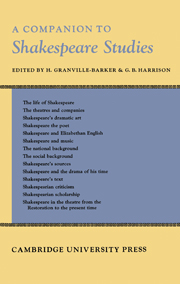Book contents
- Frontmatter
- Contents
- ILLUSTRATIONS
- Preface
- The Life of Shakespeare
- The Theatres and Companies
- Shakespeare's Dramatic Art
- Shakespeare the Poet
- Shakespeare and Elizabethan English
- Shakespeare and Music
- The National Background
- The Social Background
- Shakespeare's Sources
- Shakespeare and the Drama of his Time
- Shakespeare's Text
- Shakespearian Criticism
- Shakespearian Scholarship
- Shakespeare in the Theatre from the Restoration to the Present Time
- Reading List
- Appendices
- Index
- Plate section
The Theatres and Companies
Published online by Cambridge University Press: 05 August 2012
- Frontmatter
- Contents
- ILLUSTRATIONS
- Preface
- The Life of Shakespeare
- The Theatres and Companies
- Shakespeare's Dramatic Art
- Shakespeare the Poet
- Shakespeare and Elizabethan English
- Shakespeare and Music
- The National Background
- The Social Background
- Shakespeare's Sources
- Shakespeare and the Drama of his Time
- Shakespeare's Text
- Shakespearian Criticism
- Shakespearian Scholarship
- Shakespeare in the Theatre from the Restoration to the Present Time
- Reading List
- Appendices
- Index
- Plate section
Summary
THE CONDITIONS OF SHAKESPEARE'S ART
Dr Johnson never mentioned Garrick in his Preface to Shakespeare, and thought that ‘many of his plays are the worse for being acted’. Such a view has its dangers. Every artist has to work in his chosen medium. And drama, the most complex of all arts, proceeds by a triple process to its completion. It involves creation by the dramatist, re-creation by a company of actors on the boards of a stage, and a third incarnation in the illusion of the spectators. All three are essential, inseparable, indispensable. The closet-drama is an ignoble retreat from the proper conditions of the art. The hurly-burly of actor, stage and audience is the proper element of true drama.
It is right to think of Shakespeare, therefore, in terms of the stage as well as of literary categories. He worked in his medium, and there is evidence enough that he was content to do so. A good workman does not quarrel with his tools. And Shakespeare was no less craftsman than artist–words that the Elizabethan joined together and that modern confusions have divorced. His drama was rooted in his own age and in the conditions of his art, in the stage and its habits, in the audience and its tastes, as well as in the drama of earlier generations in England. What he learned of others, what was imposed upon him by the conditions of his occupation, as well as what he gave of his own, has come down to us blended together in his plays.
- Type
- Chapter
- Information
- Companion to Shakespeare Studies , pp. 9 - 44Publisher: Cambridge University PressPrint publication year: 1934



